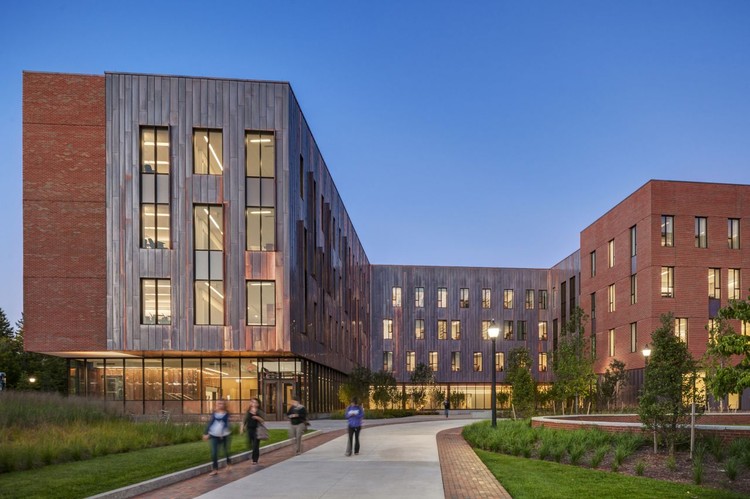
-
Architects: Leers Weinzapfel Associates
- Year: 2012
-
Photographs:Anton Grassl/Esto, Charles Mayer

Text description provided by the architects. Located at the center of campus, two new classroom buildings frame the nexus of student interchange where two primary pedestrian paths cross at an existing plaza. Tied together by a new sustainable landscape inspired by the agrarian past, the buildings provide a home for five social sciences and humanities departments and house a total of 40 new high technology classroom facilities, ranging from a 400-seat lecture hall to small seminar rooms, as well as 12 specialized departmental teaching spaces.

The design challenge was to create two animated student magnet buildings to reinforce the central pedestrian crossroads of Fairfield and Academic Way, and to address a number of campus master-planning objectives. These include reinforcing Academic Way as the main north-south pedestrian corridor, realigning Fairfield Way, reflecting pedestrian desire lines, developing an articulated hierarchy of spaces and paths, densifying the built campus core, and creating a humane campus in scale, function, and materials. Oak Hall emphasizes Academic Way as the primary north-south walkway, strengthening its shift in direction by projecting into Fairfield Way; at this junction it helps frame the Library Plaza as the heart of the campus. A similar projection of Laurel Hall into Fairfield Way helps to create a narrower, more pedestrian-friendly walkway from the Library Plaza to the Student Union Circle. The central lobby space of Laurel Hall follows the diagonal path that leads from the Library Plaza to the Student Union dining areas. Oak and Laurel Halls provide a series of memorable outdoor spaces, including new connected courtyards and a green roof respectively. Laurel Hall completes the boundary of the Student Union Quadrangle and defines it as the most significant open space within the campus. Dividing the total program into two volumes allows the massing of each building to be reduced to better relate to neighboring buildings and the pedestrian scale. Glass enclosed lobbies and walkways at ground level create welcoming entrances and the impression of permeability.

In addition to campus planning objectives, educational challenges included: 1. Creating a classroom-only building at Laurel Hall that would be enjoyed and be treated respectfully by students and be available for conferences in conjunction with the adjacent Student Union. 2. Designing a variety of general-purpose classroom and lecture hall spaces to standardized criteria for advanced learning and high-tech teaching support developed in cooperation with the University’s Faculty Classroom Committee and Institute of Teaching and Learning (ITL). 3. Designing specialized classrooms and labs to department-specific criteria including computerized language labs, journalism interview and television production spaces, linguistic analysis labs, departmental seminar rooms, and shared colloquium spaces.

The westernmost building, Laurel Hall (68,370 gsf), is organized around an interior public area, a light-filled central atrium. Two large lecture halls are housed in a compact copper volume with an extensively planted green roof; across the atrium, 17 smaller classrooms are stacked in a three-story brick volume that bounds the Main Quadrangle. Student seating and waiting space is provided near all classrooms at every level.

Diagonally across Fairfield Way, the two L-shaped brick wings of Oak Hall (132,030 gsf) create an exterior public space comprised of two interconnected copper-lined courtyards, which are used in all seasons by individual students and classes. A large day-lit lecture hall and ten classrooms occupy the ground level; students and faculty interact in the public galleries surrounding the courtyards. The three upper floors accommodate an additional ten smaller classrooms as well as the five departments and their several hundred offices and specialized teaching spaces.

All entries in both buildings are on-grade to allow universal access. Sloping walkways in public areas allow convenient universal access to front and back of large lecture halls, which also include bariatric seating. The 200-seat lecture halls in both buildings are fully accessible throughout, with ramped aisles. The 400-seat lecture hall maintains a sloped floor area at the front of the hall to provide a more intimate feeling at the front of the space; the rear of the room is stepped up to the second floor level. All rooms are accessible; in addition to accessible gender-specific toilets, universal toilet rooms are provided in each building.

The University and Architect have worked closely together to develop environmentally responsible principles to guide the design of the buildings, which were especially shaped by the campus need for water stewardship. Laurel Hall, completed in 2011, has been awarded LEED Gold; Oak Hall, completed in 2012, is also on track for LEED Gold certification.

The same palette of materials, copper and brick, is used on the exterior of both buildings to create a more coherent campus center. Steel-framed structure creates welcoming cantilevered covered entries in both buildings. Regional brick from Maine faces Laurel Hall’s classroom bar and encloses the outer perimeter of Oak Hall’s upper three departmental floors. The buildings feature natural Vermont slate floors, built-in slate or bamboo benches, white glass posting walls, perforated stainless steel or glass guardrails, and maple doors and ceilings. Copper column covers continue the exterior material experience into the interior.

Together, the two new buildings resonate with each other, bringing the vitality of intensively used learning space to the center of campus while creating memorable new landscape spaces.












































